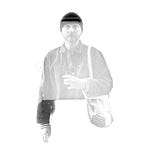On Jean-Luc Godard’s Alphaville. A Film About Stealing Talent.
As a film by any other maker Alphaville, the 1966 science-fiction, crime hybrid, would surely rank as a career highlight. For Jean-Luc Godard though the film came in amidst the most extraordinary of runs, and the director’s most celebrated period, sandwiched in between the likes of Pierrot Le Fou, Une Femme Mariée and Le Mépris. Within this context it’s actually kind of tempting to declare it a lesser work by the prolific filmmaker.
Fusing Orwell with the B-movie detective flick, Alphaville is one of the director’s rare divergences in to genre cinema. Andrew Sarris famously called it “a science fiction film without special effects”, with Godard relying on the moderinist architecture of Post-WWII Paris to tell his story. That Alphaville remains one of the key science fiction movies of the 1960s, and is spoken of in the same breath as Stanley Kubrick’s 2001: A Space Odyssey and Franklin J. Schaffner’s Planet Of The Apes is a testament to strength of the director’s vision.
The film sees the detective Lemmy Caution (played by American émigre Eddie Constantine) from “the Outlands” infiltrate the futuristic city state of Alphaville under the guise of journalism, but whose real aim is to convince the creator of Alpha 60, the evil computer that controls the entire metropolis (a precursor to Arthur C. Clarke’s HAL-9000), to return to flee the city and seek exile in the Outlands.
The film’s MacGuffin, a man named Professor von Braun, is clearly a filmic re-rendering of real-life Nazi-scientist-turned-NASA-boffin Wernher von Braun, who, having being a key figure of the Third Reich, would eventually work for the American government, but it’s also possible to read him as being something of a vessel for Godard’s thoughts on the American cinema at the time of the production of Alphaville. In the wake of the breakthrough success of The 400 Blows and Breathless both Godard and Francois Truffaut were offered the chance to work in the US. Their most notable Hollywood encounter came with with Warren Beatty, who offered both men the chance to direct Bonnie & Clyde. Truffaut eventually turned it down in order to direct his own science-fiction film, the Ray Bradbury adaptation Fahrenheit 451, while Godard rejected Beatty’s offer as he didn’t “trust” Hollywood.
The notion of the Hollywood film industry pilfering talent from overseas was not a new one by the mid-1960s, with the practice little short of standard operating procedure from the silent era on, when German filmmaker Friedrich Wilhelm Murnau was drawn to America by the promise of a blank cheque and complete creative freedom by William Fox himself. Talents as diverse as Ernst Lubitsch, Fritz Lang, Max Ophuls and Alfred Hitchcock all wound up leaving their own national film industries for America, for one reason or another, and it would be fair to suggest that the presence of such luminaries is what helped to propel Hollywood forward as the pre-eminent creative force in world cinema.
While accusating Hollywood of stealing talent might bea bit strong, the manner with which Hollywood attracted so many talented figures raises many questions, not least ones concerned with how much of a negative impact such talent migration has on national cinemas.
Godard himself would never work in the US, though did come close to doing so following a visit to Francis Ford Coppola’s Zoetrope Studios in the late 1970s. Impressed and inspired with the American filmmaker’s set-up, Godard set to work on The Story, an ambitious Las Vegas-set gangster tale concerned with Bugsy Siegel, that was envisioned by the director as a vehicle for Robert De Niro and Diane Keaton. Such a tale would have been apt for a filmmaker whose passion for cinema came from the Golden Age Of Hollywood, an era partially founded on gangster films with complex characterisation, by directors like Howard Hawks, Sam Fuller, and Nicholas Ray. Keaton, perhaps the most in-demand Hollywood actress of the day, couldn’t commit to the project though, and, as was the case on countless Godard productions at the time, The Story ceased to be.
Given the reverence shown by Godard towards the American film industry and the importance of the Hollywood picture in his early days as a film critic and then film maker it’s with a tinge of sadness and disappointment to think that we never did get to see the two cinematic monoliths collaborate with one another, even if not to quell simple curiosity as much as anything else. The closest we’ll get to such insight is 1987's King Lear, which the director came to work on with Cannon Films. Keaton’s Annie Hall co-star Woody Allen featured, as did other Hollywood icons, including Burgess Meredith, Molly Ringwald and Peter Sellers (one of the most notable Hollywood imports of the 20th Century), but Cannon and their practices were infamously about as far removed from Hollywood as one could hope to be within the American film industry.
Attached below is The New World, Godard’s earlier attempt at a dystopian nuclear love story. Made in 1963, for the anthology film, Ro.Go.Pa.G., it can be found online, but I’d recommend purchasing the Blu-ray.
